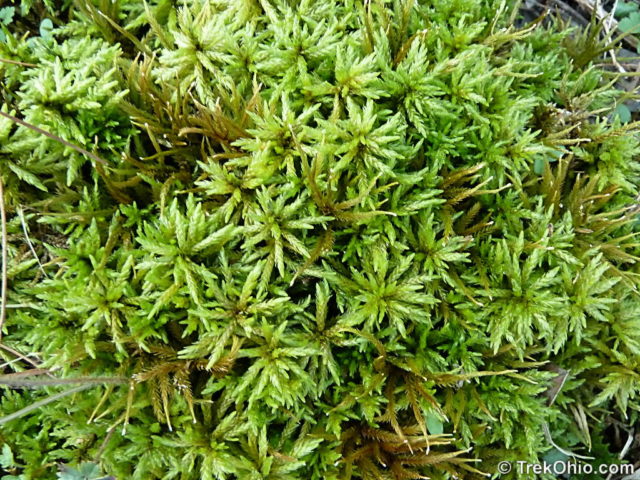In science fiction, there’s something called “terraforming” where people take an inhospitable, alien habitat and make it more earth-like so that people can live there. Well it turns out that sphagnum moss has mastered something similar — I’m going to call it “boggaforming” — where it takes a wetland and makes it more and more bog-like. One its secret weapons in this process is dead sphagnum moss. Here are some of the ways that previous generations of sphagnum moss contribute to the success of the current generation.

- Living sphagnum moss floats on top of a raft of dead sphagnum moss.
- By keeping the living moss above the water level, the dead moss helps the living moss get more sunlight, so it can produce more nutrition for itself via photosynthesis.
- The dead moss releases acid as it breaks down.
- Since the living moss is an acid-loving plant, more acid is better. Meanwhile this acidity creates a barrier for the alkaline-loving vegetation that typically dominates Ohio’s wetlands. This gives the moss an edge in preserving its habitat once it has gained a foothold.
- The dead moss has a sponge-like ability to absorb water.
- Some species can absorb up to 20 times their weight in water. This benefits the moss in several ways.
- The living moss can survive off the water that the dead moss has stored in the event of a dry spell.
- The moisture held by the dead moss increases the humidity of the air immediately above the surface of the moss, which helps keep the living moss from drying out.
- The waterlogged, dead moss forms an anaerobic environment (one without air). This prevents aerobic bacteria (the kind that need oxygen) from being able to survive.
- The dead moss insulates the water within it, making it colder than it would be otherwise.
- This gives the moss another edge over Ohio’s more typical wetland vegetation. Since the moss thrives in colder regions of the Northern hemisphere, the insulating ability of the dead moss creates a relatively colder micro-climate that’s more to its liking. It also artificially shortens the growing season for any other seeds that light upon it, so Ohio’s more typical wetland plants don’t have as much time to germinate and go to seed as they need.
- The dead moss releases tannins as it breaks down.
- The released tannins have antibacterial properties, so this makes it harder for even anaerobic bacteria to live within the waterlogged, dead moss (anaerobic bacteria are the ones that don’t need oxygen). Since bacteria play a major role in the decomposition of organic matter, without much bacteria the dead sphagnum moss decays very slowly. This prolongs the period of time in which the dead moss can continue to assist its descendants. It also means that in terms of mass the living moss is dwarfed by the dead moss. Typically the living moss is no more than an inch or so high. But after thousands of years of accumulation, the dead moss in Cranberry Bog has grown to be 36 feet deep.
All this “boggaforming” has been very important to the peat bogs in Ohio because… well, because they don’t really belong here. The vegetation found in our bogs typically thrives in more northern climates. However these northern plants were more or less “pushed” south during the last ice age as the ice sheet expanded into Ohio. When the ice sheet began its final retreat, the environmental conditions became less and less favorable to these plants. However some outposts were created for them in kettle lakes, and the moss pitched in by adding acid and tannins to the water and even impacting the wetland’s micro-climate.
How people have made use of peat bogs
The dead sphagnum moss is usually called peat, and a wetland where sphagnum moss grows is often called a peat bog. Here are some interesting ways that people have used or exploited dead sphagnum moss (peat) over the years.
- Gardeners have added dead sphagnum moss to sandy soil to increase its ability to retain water
- Ancient people in Europe used peat bogs to preserve food. Contemporary scientists have discovered butter and lard that were buried 2000 to 3000 years ago. The original substance was basically transformed into generic animal fat, but after all the years it was buried, it was still intact due to the cold, acidic, anaerobic, antibacterial environment in which it was buried.
- Ancient people in Europe also interred people in peat bogs (especially people who were human sacrifices). If you’re of an archeological bent, you might be interested in reading more about this.
- Medics took advantage of the antibacterial properties of dried sphagnum moss in WWI, using it in bandages to help prevent wounds from becoming infected. Now we know that there is some risk of introducing a fungal infection (Sporotrichosis) from doing this, so the practice has been discontinued.
- Some Native American people used dried sphagnum moss to create super-absorbent diapers for their youngsters.
- The iron ore that the Vikings smelted to create their weapons and armor was Bog Iron. The chemical soup that makes up a bog caused the iron in the water to oxidize and precipitate into this ore. Interestingly impurities in the iron (silicates) helped to make the Viking’s weapons resistant to rusting once forged.
- In many northern climes without trees, peat moss has traditionally been burned for fuel.
- In older times in some Celtic regions (like Scotland), the people actually built homes out of peat much the way people living in America’s prairies made homes out of sod.

Additional information
- Wikipedia: Sphagnum
- Wikipedia: Peat
- Wikipedia: Tannin
- Wikipedia: Sporotrichosis — this is a fungal disease that might be contracted if sphagnum moss is used to dress wounds
- Wikipedia: Bog Iron — the iron smelted by the Vikings
- Wikipedia: Bog Butter
- Wired Science: Bogosphere: The Strangest Things Pulled Out of Peat Bogs